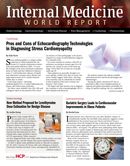Publication
Article
Internal Medicine World Report
New Method Proposed for Levothyroxine Dose Estimation for Benign Disease
Author(s):
Patients' body weight (BW) is the accepted way to calculate the starting dose of levothyroxine (LT4) after total thyroidectomy. However, Italian researchers sought to find a new way to improve the accuracy of the LT4 starting dose following total thyroidectomy by identifying other major predictive factors of LT4 requirement.

Patients’ body weight (BW) is the accepted way to calculate the starting dose of levothyroxine (LT4) after total thyroidectomy. However, Italian researchers sought to find a new way to improve the accuracy of the LT4 starting dose following total thyroidectomy by identifying other major predictive factors of LT4 requirement. Other researchers have suggested body mass index (BMI) or body surface, sex and menopause, age, and the disease that causes hypothyroidism.
In their 2-phase study published online in Thyroid on September 30, 2014, Vincenzo Di Donna, MD, and colleagues at Rome’s Universita Cattolica Del Sacro Cuore retrospectively identified 92 adult patients who had undergone a total thyroidectomy for benign disease and had begun LT4 treatment at a dose of 1.6 µg/kg/d (Retrospective Cohort). Adjustments were made at the postsurgery follow-up to optimize the LT4 dose based on serum thyroid stimulating hormone (TSH) levels. The results of this analysis were then used to formulate a nomogram to properly calculate the LT4 starting dose used prospectively in the second part of the study on 31 consecutive patients (Prospective Cohort).
At first follow-up 40% of the patients in the Retrospective Cohort were euthyroid. Researchers found significant correlations between optimal dose of LT4 and BW, body mass index (BMI), age, preoperative mean corpuscular volume (MCV), and Free T3 hormone (FT3). The optimal LT4 dose showed an inverse relationship with BMI and age, ranging from 1.4 to 1.8 µg/kg/d. In the Prospective Cohort, using an age- and BMI-related nomogram improved prediction of the optimal LT4 starting dose; 68% of patients were euthyroid at first follow-up compared with 41% of patients who were euthyroid after using BW to calculate best LT4 dosage, as recommended in the literature.
The investigators concluded that BW is not the only variable that can be used to predict LT4 dose. The use of their nomogram based on BMI and age predicted the correct starting dose of LT4 in 68% of patients compared with 40% in who BW only was used. “This performance could allow a more cost-effective management of postsurgical hypothyroidism,” they conclude.





